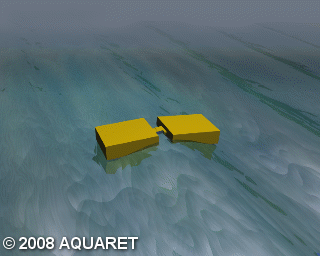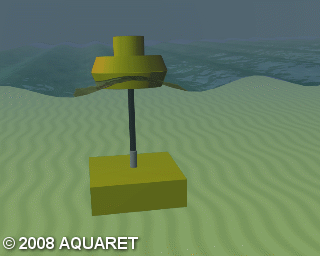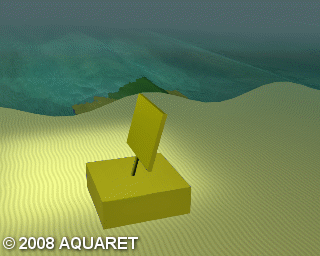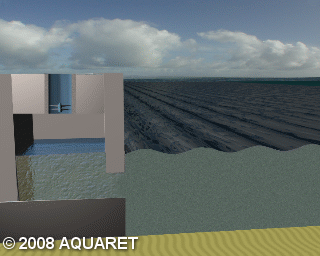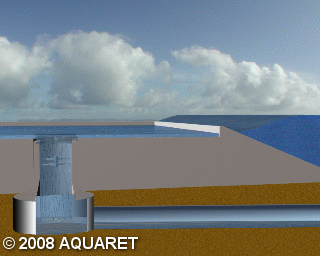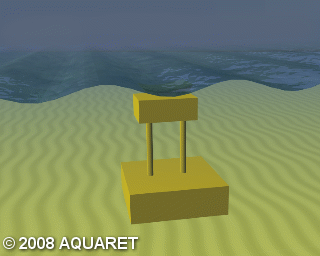Wave Energy Generation
Steven Brace 2010
Currently a huge amount of time and money is being invested in the research, development and implementation of technologies to exploit renewable energy sources; it is estimated that £95-billion was invested in new renewable capacity in 2009 alone. [1] In the Department of Energy and Climate Change's 2009 report plans were set out to raise the production of energy from renewables to 30% of the total; some believe that electricity harnessed from wave power could be the solution to meeting these goals.
Wave formation and energy potential
Waves are formed by the sustained flow of wind above the surface of an area of water. Energy is transferred from the air to the water where it is accumulated as potential and kinetic energy.
 |
[3] This diagram shows the generation process of wind-waves, it shows how the flow of air causes differential pressures that steepen the waves. Positive and negative areas of pressure are shown by the plus and minus symbols. The curved arrows represent the flow of air and fluid. This is known as the Jeffrey's 'sheltering' model of wave generation. |
The energy possessed by a wave is affected by several factors including the wind speed and distance of open water over which they were generated. Waves move freely with little resistance in deep water and consequently once winds subside waves can easily continue for great distances, some as far as ten thousand kilometres. [2] Because of their ability to travel unaffected there is a much larger concentration of wave activity on coastlines exposed to large expanses of water and prevailing winds.
Because of their position the west coasts of the Americas, Europe, Australia and new Zealand are potentially huge sources of this renewable energy. It is estimated that the worldwide deep water wave power resources that could be practically captured are in excess of 2TW (13% of global energy consumption); estimates also predict 15-25% of current UK demand could be fulfilled by wave energy power generation. [4][5] Some wave farming projects have already begun, or are in development, a few significant schemes are listed on the map below.
Worldwide Wave-Farm Developement
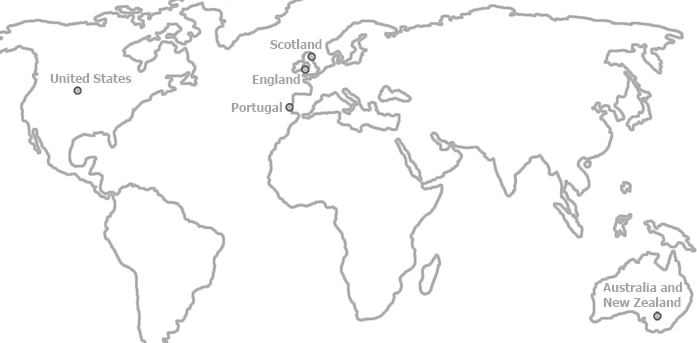
Scotland
The UK and Scottish Governments are providing significant funding for new wave farm projects; encouraging this new sector could introduce many jobs and a lot of money into the area. In the 1980s Denmark took advantage of the new market in wind turbines encouraging the sector which is now worth more than £3 billion a year to that country. [6]
Pelamis Wave Power
| BBC report on the installation of new Pelamis Wave machines in Leith, Scotland. |
The Scottish Government has invested £4 million in the construction and deployment of 4 Pelamis Wave machines. When completed this wave-farm will have the largest output capacity world-wide with an average yield of 3MW. [7]
Pelamis currently has 5 projects in development around the Scottish coast, the largest planned site off the north coast of Sutherland has the goal to generate up to 50MW of power by the end of its second phase. [8]
Siadar Wave Energy Project
Plans to build a 4MW wave farm by npower renewables were approved by the Scottish Government in 2009. The station is based on Oscillating Water Column technology. [9] OWCs make use of a large column into which waves flow, these waves pressurise the air inside the column and force it through a wells turbine (a turbine which rotates in the same direction regardless of which way the air flow is coming from); the turbine in turn is connected to a generator.
| This video shows the outlet of an OWC type wave power generator, the power of the air stream can be clearly heard and seen. |
The first ever commercial wave farm began operation 5km off the coast of Portugal on the 15th July 2008. [10] The farm makes use of the same pelamis wave machines that are being installed around the Scottish coast. The three machines are capable of generating 750kW each, coming to a total installed capacity of 2.25MW. [10] The machines were taken out of action 2 months after they were deployed due to technical problems with the joints; and are now indefinitely out of service due to their owners moving into liquidation. [11]
United States
The wave energy potential in the United States is estimated to be equal to 6.5% of its current total capacity. However there are currently very few projects being planned to exploit this large resource. [12] Notably the first wave farm to be built in the US has begun construction near Oregon. The farm makes use of OPTs power buoy technology. [13] Large buoys float on the surface of the water and move with the waves; this movement is used to pump hydraulic fluid that is then used to turn a generator and produce electricity.
| Installation of one of the first power buoys by Ocean Power Technologies. The power buoy is an example of a single point absorber type of wave power generator. |
England
| 16KM off the coast of Cornwall a wave power research project has begun with the aim of encouraging investment in the R&D of wave energy generation devices. The intention of the 'Wave Hub' project is to make it easier for developers to deploy their wave power devices without having to spend large amounts on developing infrastructure to transport the energy to the grid. [14] | |
| The scheme consists of a 25km subsea cable connecting a 12 tonne hub to the UKs nation grid (via a controller and other power conditioning equipment at the shore). Currently the hub has a 20MW capacity. [14] Three projects have been confirmed to be implemented at the wave hub project; including OPT who are also constructing the first wave farm in the US. | 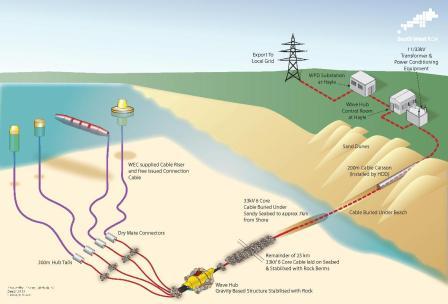 |
Australia and New Zealand
Just as in Europe and America the western coast of Australia and New Zealand has great potential for the production of electricity from wave energy devices. New Zealand's National Institute of Water and Atmospheric Research estimates that the country's ocean waves carry on average 25kW per metre of coastline. [15]
The most noteworthy implementation of wave power in Australia and New Zealand is the oscillating water column generators made by Oceanlinx. This company's makes use of turbines with variable pitch blades in order to generate electricity from a bi-directional flow of air. This has efficiency advantages over the more common well's turbine approach.
| This video shows the inner workings of the Oceanlinx oscillating water column type turbine with its new variable pitch blade turbines. |
Many different techniques have been implemented to harness energy from wave power; EMEC has categorised the variety of different devices into these 6 categories.
1. Sawin, Eric Martinot and Janet. Renewables Global Status Report 2009 Update. s.l. : Renewable Energy World, 2009.
2. Brooke, John. Wave energy conversion, Volume 6 By Engineering Committee on Oceanic Resources. s.l. : Working Group on Wave Energy Conversion, 2003.
3. http://misclab.umeoce.maine.edu/boss/classes/SMS_491_2003/Week_6.htm
4. Cruz, João. Ocean wave energy: current status and future prepectives. 2008.
5. http://www.pelamiswave.com/wave-energy/the-resource
6. http://business.scotsman.com/alternativeenergysources/Scotland-seas-into-the-future.3348444.jp
8. http://www.pelamiswave.com/our-projects/farr-point-wave-farm
9. http://news.bbc.co.uk/1/hi/scotland/highlands_and_islands/7844782.stm
10. http://news.bbc.co.uk/1/hi/scotland/4563077.stm
12. http://news.bbc.co.uk/1/hi/technology/6410839.stm
14. http://www.wavehub.co.uk/about_wave_hub.aspx
15. Stevens, Craig, Smith, Murray and Gorman, Richard. Ocean bounty: energy from waves and tides.s.l. : Water & Atmosphere, Vol.13, No.4., 2005.
